Accounting and Financial Reporting: Contingent Liabilities and Assets
VerifiedAdded on 2023/03/31
|6
|1155
|261
Report
AI Summary
This report provides an overview of accounting and financial reporting, specifically focusing on contingent liabilities and intangible assets within the AASB framework. It delves into the rules and requirements for recognizing and measuring these items in financial statements. The report discusses the conditions under which contingent liabilities should be recorded, emphasizing the probability of economic outflow. It also examines the accounting treatment of intangible assets, differentiating between those with finite and indefinite lives, and the implications of IAS 38 and IFRS standards. The report addresses the classification of intangible assets based on their lives, the methods of amortization, and the treatment of internally generated assets, including research and development costs. The conclusion summarizes the key aspects of asset measurement and liability recognition, highlighting the importance of accurate financial reporting in accordance with accounting standards. The report includes references to relevant accounting standards.
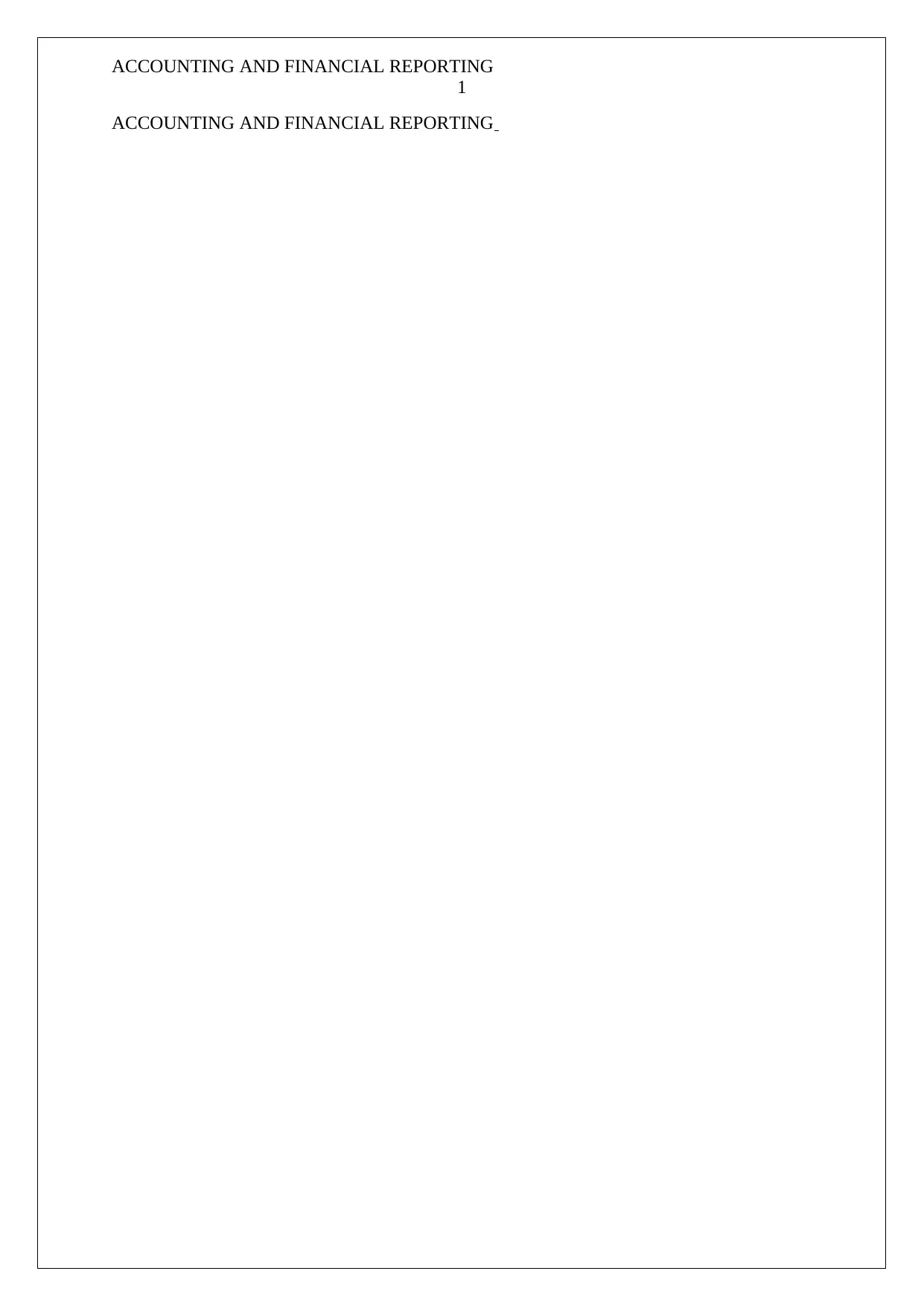
ACCOUNTING AND FINANCIAL REPORTING
1
ACCOUNTING AND FINANCIAL REPORTING
1
ACCOUNTING AND FINANCIAL REPORTING
Paraphrase This Document
Need a fresh take? Get an instant paraphrase of this document with our AI Paraphraser
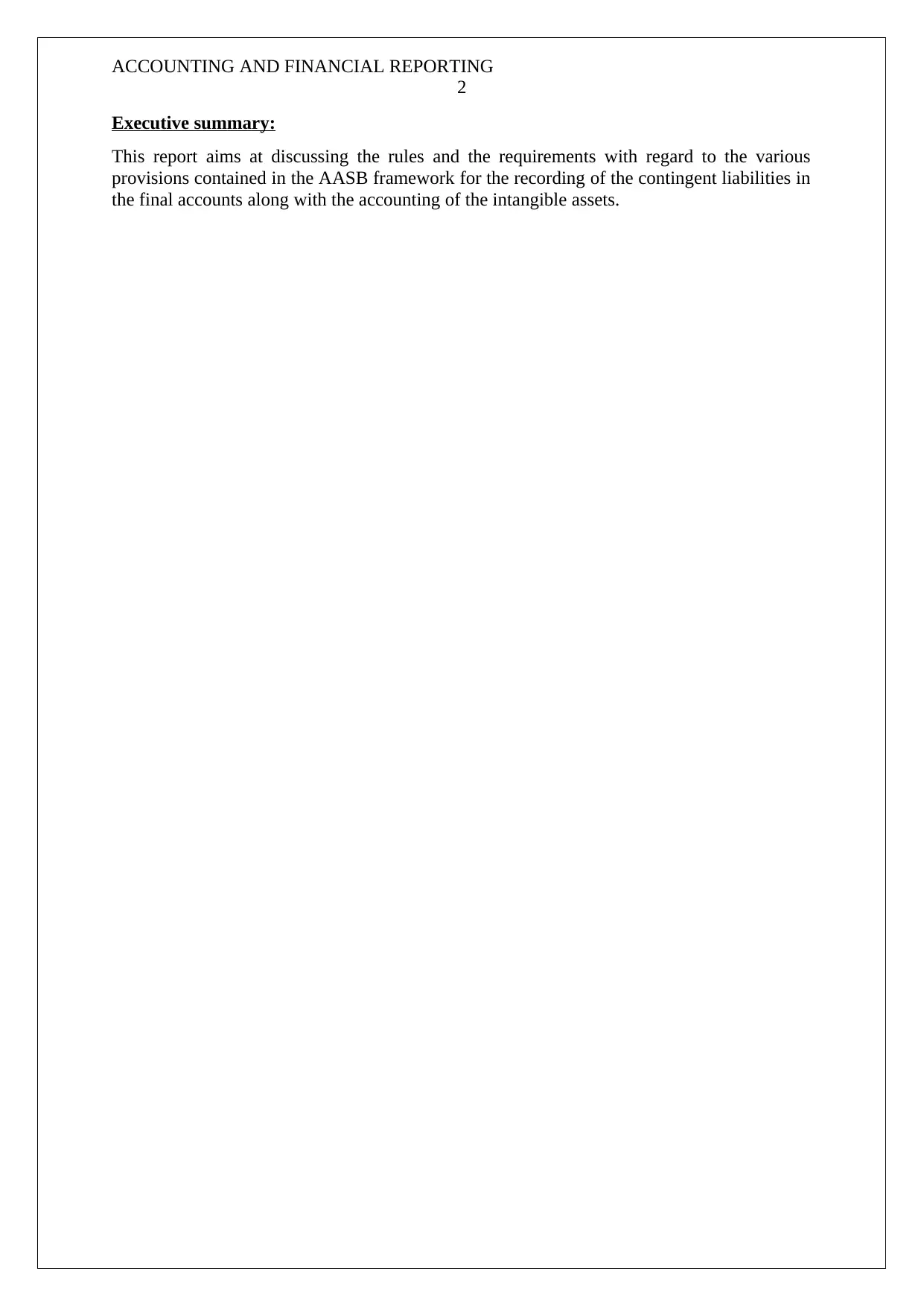
ACCOUNTING AND FINANCIAL REPORTING
2
Executive summary:
This report aims at discussing the rules and the requirements with regard to the various
provisions contained in the AASB framework for the recording of the contingent liabilities in
the final accounts along with the accounting of the intangible assets.
2
Executive summary:
This report aims at discussing the rules and the requirements with regard to the various
provisions contained in the AASB framework for the recording of the contingent liabilities in
the final accounts along with the accounting of the intangible assets.
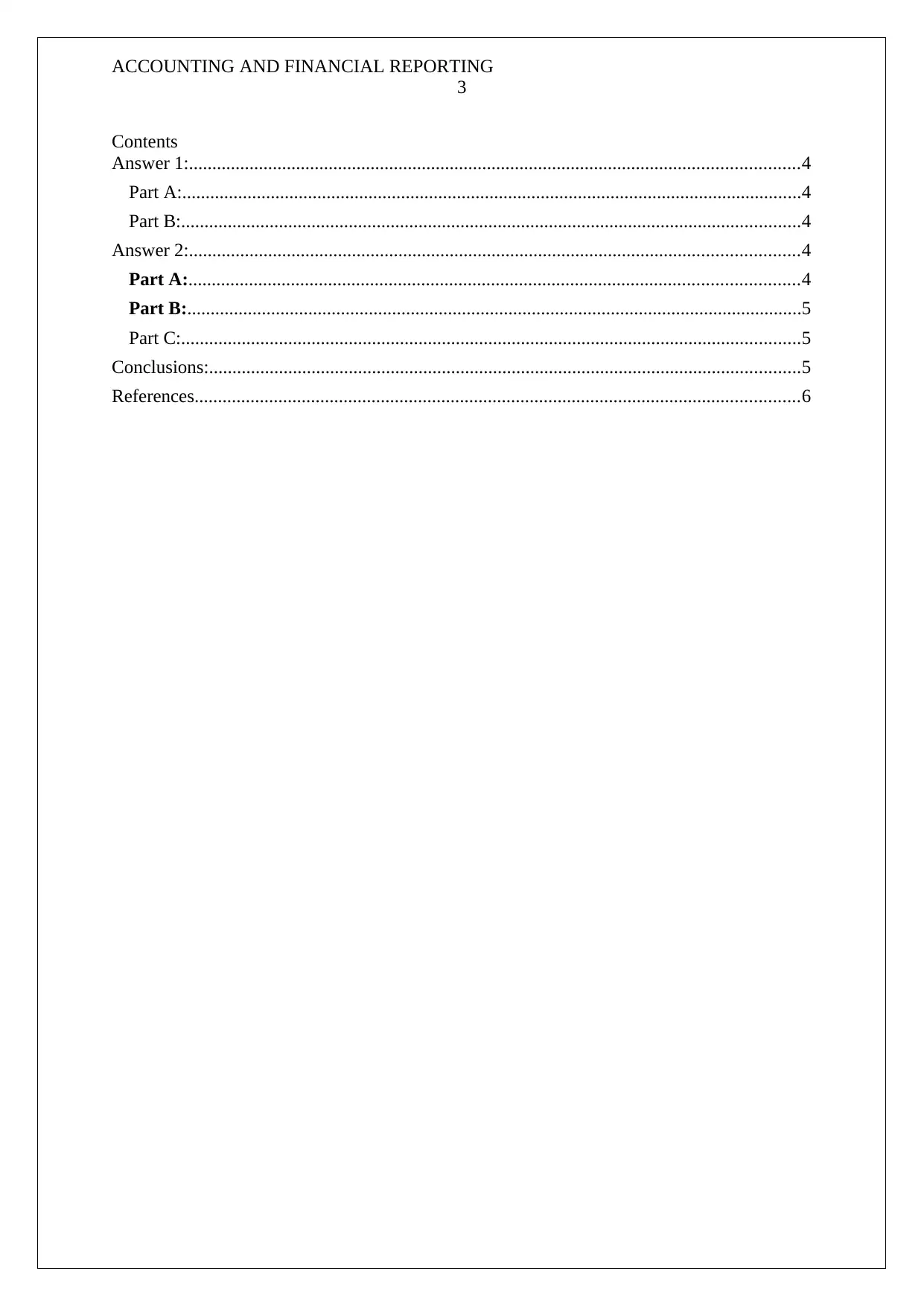
ACCOUNTING AND FINANCIAL REPORTING
3
Contents
Answer 1:...................................................................................................................................4
Part A:.....................................................................................................................................4
Part B:.....................................................................................................................................4
Answer 2:...................................................................................................................................4
Part A:...................................................................................................................................4
Part B:....................................................................................................................................5
Part C:.....................................................................................................................................5
Conclusions:...............................................................................................................................5
References..................................................................................................................................6
3
Contents
Answer 1:...................................................................................................................................4
Part A:.....................................................................................................................................4
Part B:.....................................................................................................................................4
Answer 2:...................................................................................................................................4
Part A:...................................................................................................................................4
Part B:....................................................................................................................................5
Part C:.....................................................................................................................................5
Conclusions:...............................................................................................................................5
References..................................................................................................................................6
⊘ This is a preview!⊘
Do you want full access?
Subscribe today to unlock all pages.

Trusted by 1+ million students worldwide
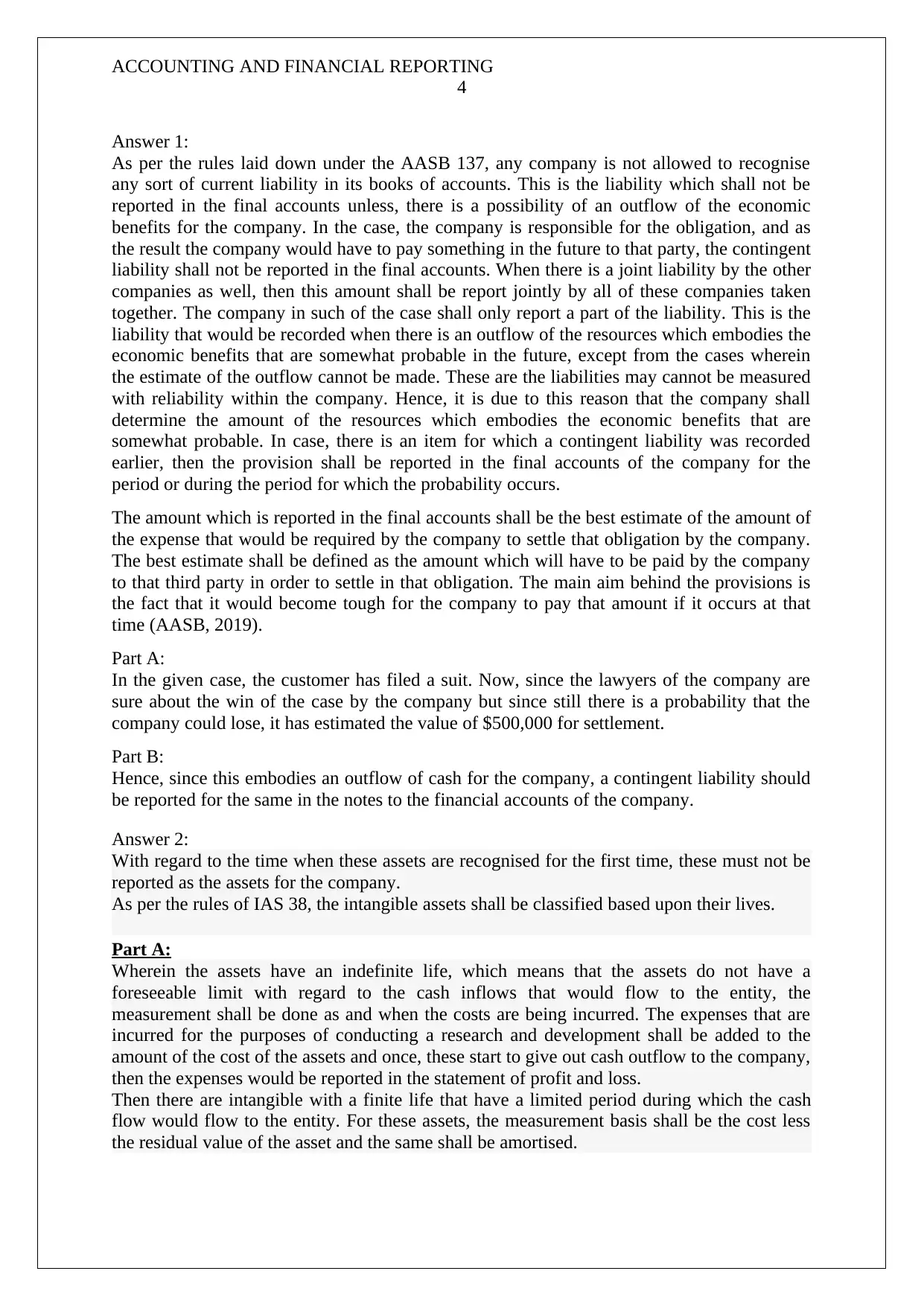
ACCOUNTING AND FINANCIAL REPORTING
4
Answer 1:
As per the rules laid down under the AASB 137, any company is not allowed to recognise
any sort of current liability in its books of accounts. This is the liability which shall not be
reported in the final accounts unless, there is a possibility of an outflow of the economic
benefits for the company. In the case, the company is responsible for the obligation, and as
the result the company would have to pay something in the future to that party, the contingent
liability shall not be reported in the final accounts. When there is a joint liability by the other
companies as well, then this amount shall be report jointly by all of these companies taken
together. The company in such of the case shall only report a part of the liability. This is the
liability that would be recorded when there is an outflow of the resources which embodies the
economic benefits that are somewhat probable in the future, except from the cases wherein
the estimate of the outflow cannot be made. These are the liabilities may cannot be measured
with reliability within the company. Hence, it is due to this reason that the company shall
determine the amount of the resources which embodies the economic benefits that are
somewhat probable. In case, there is an item for which a contingent liability was recorded
earlier, then the provision shall be reported in the final accounts of the company for the
period or during the period for which the probability occurs.
The amount which is reported in the final accounts shall be the best estimate of the amount of
the expense that would be required by the company to settle that obligation by the company.
The best estimate shall be defined as the amount which will have to be paid by the company
to that third party in order to settle in that obligation. The main aim behind the provisions is
the fact that it would become tough for the company to pay that amount if it occurs at that
time (AASB, 2019).
Part A:
In the given case, the customer has filed a suit. Now, since the lawyers of the company are
sure about the win of the case by the company but since still there is a probability that the
company could lose, it has estimated the value of $500,000 for settlement.
Part B:
Hence, since this embodies an outflow of cash for the company, a contingent liability should
be reported for the same in the notes to the financial accounts of the company.
Answer 2:
With regard to the time when these assets are recognised for the first time, these must not be
reported as the assets for the company.
As per the rules of IAS 38, the intangible assets shall be classified based upon their lives.
Part A:
Wherein the assets have an indefinite life, which means that the assets do not have a
foreseeable limit with regard to the cash inflows that would flow to the entity, the
measurement shall be done as and when the costs are being incurred. The expenses that are
incurred for the purposes of conducting a research and development shall be added to the
amount of the cost of the assets and once, these start to give out cash outflow to the company,
then the expenses would be reported in the statement of profit and loss.
Then there are intangible with a finite life that have a limited period during which the cash
flow would flow to the entity. For these assets, the measurement basis shall be the cost less
the residual value of the asset and the same shall be amortised.
4
Answer 1:
As per the rules laid down under the AASB 137, any company is not allowed to recognise
any sort of current liability in its books of accounts. This is the liability which shall not be
reported in the final accounts unless, there is a possibility of an outflow of the economic
benefits for the company. In the case, the company is responsible for the obligation, and as
the result the company would have to pay something in the future to that party, the contingent
liability shall not be reported in the final accounts. When there is a joint liability by the other
companies as well, then this amount shall be report jointly by all of these companies taken
together. The company in such of the case shall only report a part of the liability. This is the
liability that would be recorded when there is an outflow of the resources which embodies the
economic benefits that are somewhat probable in the future, except from the cases wherein
the estimate of the outflow cannot be made. These are the liabilities may cannot be measured
with reliability within the company. Hence, it is due to this reason that the company shall
determine the amount of the resources which embodies the economic benefits that are
somewhat probable. In case, there is an item for which a contingent liability was recorded
earlier, then the provision shall be reported in the final accounts of the company for the
period or during the period for which the probability occurs.
The amount which is reported in the final accounts shall be the best estimate of the amount of
the expense that would be required by the company to settle that obligation by the company.
The best estimate shall be defined as the amount which will have to be paid by the company
to that third party in order to settle in that obligation. The main aim behind the provisions is
the fact that it would become tough for the company to pay that amount if it occurs at that
time (AASB, 2019).
Part A:
In the given case, the customer has filed a suit. Now, since the lawyers of the company are
sure about the win of the case by the company but since still there is a probability that the
company could lose, it has estimated the value of $500,000 for settlement.
Part B:
Hence, since this embodies an outflow of cash for the company, a contingent liability should
be reported for the same in the notes to the financial accounts of the company.
Answer 2:
With regard to the time when these assets are recognised for the first time, these must not be
reported as the assets for the company.
As per the rules of IAS 38, the intangible assets shall be classified based upon their lives.
Part A:
Wherein the assets have an indefinite life, which means that the assets do not have a
foreseeable limit with regard to the cash inflows that would flow to the entity, the
measurement shall be done as and when the costs are being incurred. The expenses that are
incurred for the purposes of conducting a research and development shall be added to the
amount of the cost of the assets and once, these start to give out cash outflow to the company,
then the expenses would be reported in the statement of profit and loss.
Then there are intangible with a finite life that have a limited period during which the cash
flow would flow to the entity. For these assets, the measurement basis shall be the cost less
the residual value of the asset and the same shall be amortised.
Paraphrase This Document
Need a fresh take? Get an instant paraphrase of this document with our AI Paraphraser
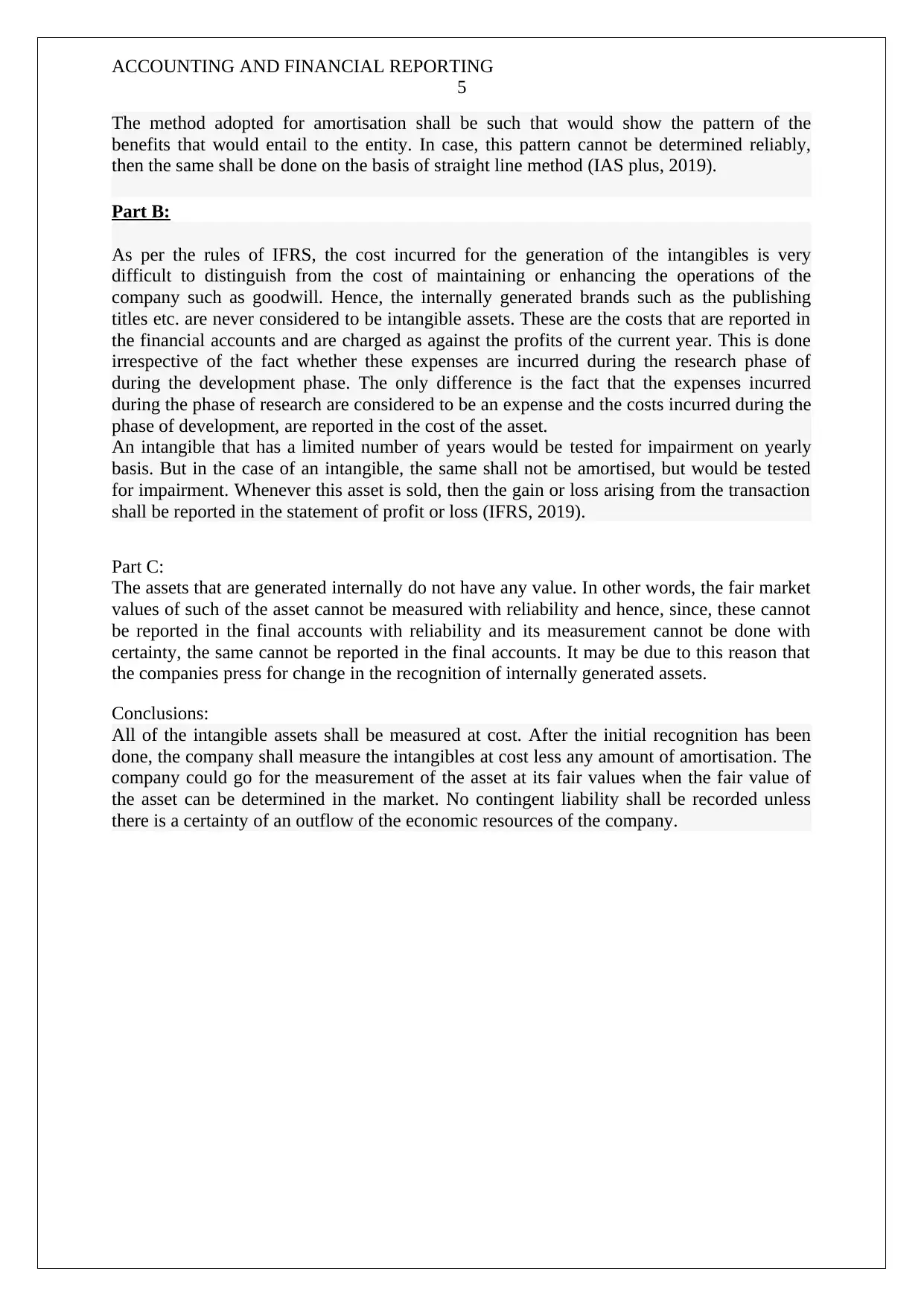
ACCOUNTING AND FINANCIAL REPORTING
5
The method adopted for amortisation shall be such that would show the pattern of the
benefits that would entail to the entity. In case, this pattern cannot be determined reliably,
then the same shall be done on the basis of straight line method (IAS plus, 2019).
Part B:
As per the rules of IFRS, the cost incurred for the generation of the intangibles is very
difficult to distinguish from the cost of maintaining or enhancing the operations of the
company such as goodwill. Hence, the internally generated brands such as the publishing
titles etc. are never considered to be intangible assets. These are the costs that are reported in
the financial accounts and are charged as against the profits of the current year. This is done
irrespective of the fact whether these expenses are incurred during the research phase of
during the development phase. The only difference is the fact that the expenses incurred
during the phase of research are considered to be an expense and the costs incurred during the
phase of development, are reported in the cost of the asset.
An intangible that has a limited number of years would be tested for impairment on yearly
basis. But in the case of an intangible, the same shall not be amortised, but would be tested
for impairment. Whenever this asset is sold, then the gain or loss arising from the transaction
shall be reported in the statement of profit or loss (IFRS, 2019).
Part C:
The assets that are generated internally do not have any value. In other words, the fair market
values of such of the asset cannot be measured with reliability and hence, since, these cannot
be reported in the final accounts with reliability and its measurement cannot be done with
certainty, the same cannot be reported in the final accounts. It may be due to this reason that
the companies press for change in the recognition of internally generated assets.
Conclusions:
All of the intangible assets shall be measured at cost. After the initial recognition has been
done, the company shall measure the intangibles at cost less any amount of amortisation. The
company could go for the measurement of the asset at its fair values when the fair value of
the asset can be determined in the market. No contingent liability shall be recorded unless
there is a certainty of an outflow of the economic resources of the company.
5
The method adopted for amortisation shall be such that would show the pattern of the
benefits that would entail to the entity. In case, this pattern cannot be determined reliably,
then the same shall be done on the basis of straight line method (IAS plus, 2019).
Part B:
As per the rules of IFRS, the cost incurred for the generation of the intangibles is very
difficult to distinguish from the cost of maintaining or enhancing the operations of the
company such as goodwill. Hence, the internally generated brands such as the publishing
titles etc. are never considered to be intangible assets. These are the costs that are reported in
the financial accounts and are charged as against the profits of the current year. This is done
irrespective of the fact whether these expenses are incurred during the research phase of
during the development phase. The only difference is the fact that the expenses incurred
during the phase of research are considered to be an expense and the costs incurred during the
phase of development, are reported in the cost of the asset.
An intangible that has a limited number of years would be tested for impairment on yearly
basis. But in the case of an intangible, the same shall not be amortised, but would be tested
for impairment. Whenever this asset is sold, then the gain or loss arising from the transaction
shall be reported in the statement of profit or loss (IFRS, 2019).
Part C:
The assets that are generated internally do not have any value. In other words, the fair market
values of such of the asset cannot be measured with reliability and hence, since, these cannot
be reported in the final accounts with reliability and its measurement cannot be done with
certainty, the same cannot be reported in the final accounts. It may be due to this reason that
the companies press for change in the recognition of internally generated assets.
Conclusions:
All of the intangible assets shall be measured at cost. After the initial recognition has been
done, the company shall measure the intangibles at cost less any amount of amortisation. The
company could go for the measurement of the asset at its fair values when the fair value of
the asset can be determined in the market. No contingent liability shall be recorded unless
there is a certainty of an outflow of the economic resources of the company.
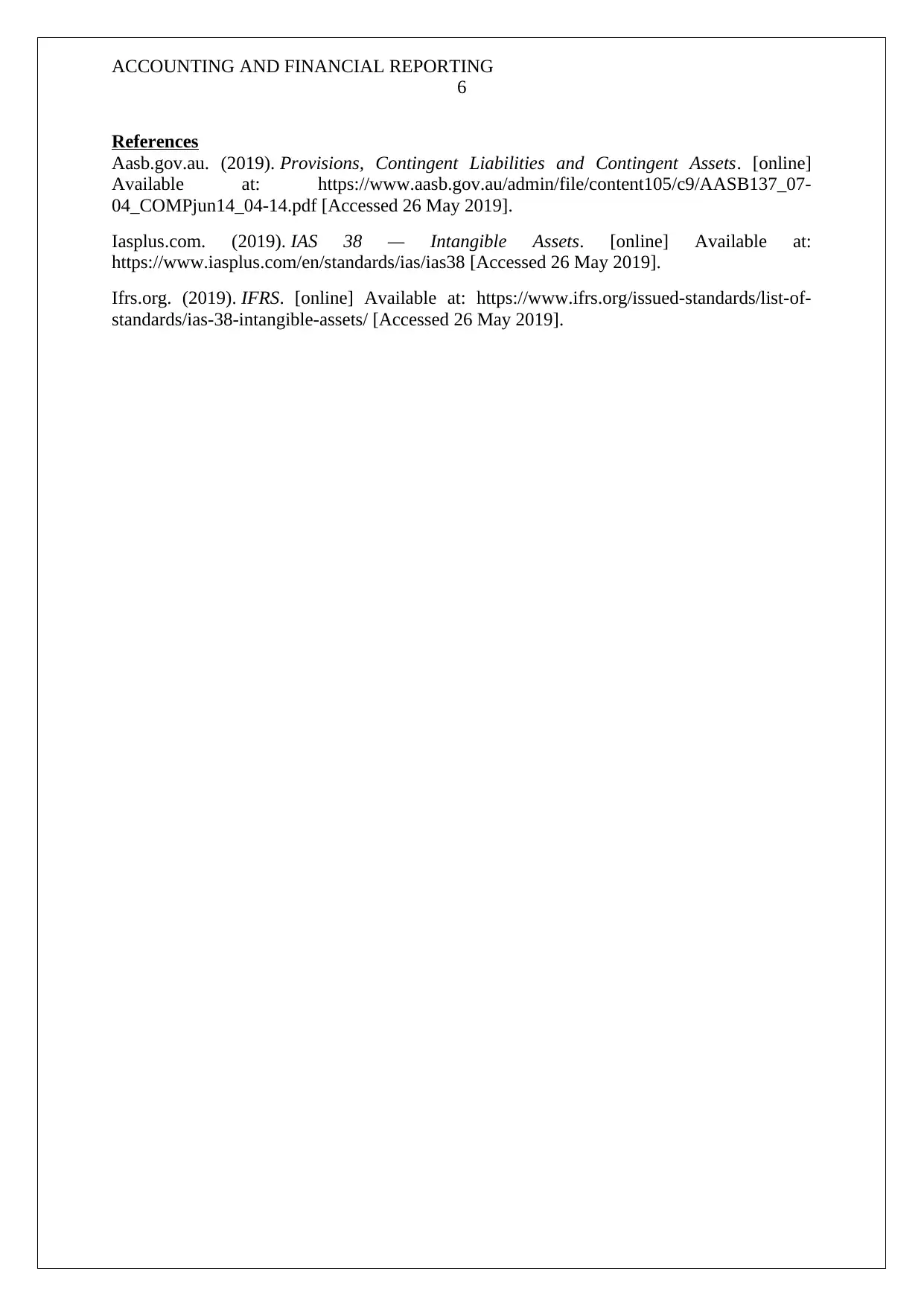
ACCOUNTING AND FINANCIAL REPORTING
6
References
Aasb.gov.au. (2019). Provisions, Contingent Liabilities and Contingent Assets. [online]
Available at: https://www.aasb.gov.au/admin/file/content105/c9/AASB137_07-
04_COMPjun14_04-14.pdf [Accessed 26 May 2019].
Iasplus.com. (2019). IAS 38 — Intangible Assets. [online] Available at:
https://www.iasplus.com/en/standards/ias/ias38 [Accessed 26 May 2019].
Ifrs.org. (2019). IFRS. [online] Available at: https://www.ifrs.org/issued-standards/list-of-
standards/ias-38-intangible-assets/ [Accessed 26 May 2019].
6
References
Aasb.gov.au. (2019). Provisions, Contingent Liabilities and Contingent Assets. [online]
Available at: https://www.aasb.gov.au/admin/file/content105/c9/AASB137_07-
04_COMPjun14_04-14.pdf [Accessed 26 May 2019].
Iasplus.com. (2019). IAS 38 — Intangible Assets. [online] Available at:
https://www.iasplus.com/en/standards/ias/ias38 [Accessed 26 May 2019].
Ifrs.org. (2019). IFRS. [online] Available at: https://www.ifrs.org/issued-standards/list-of-
standards/ias-38-intangible-assets/ [Accessed 26 May 2019].
⊘ This is a preview!⊘
Do you want full access?
Subscribe today to unlock all pages.

Trusted by 1+ million students worldwide
1 out of 6
Related Documents
Your All-in-One AI-Powered Toolkit for Academic Success.
+13062052269
info@desklib.com
Available 24*7 on WhatsApp / Email
![[object Object]](/_next/static/media/star-bottom.7253800d.svg)
Unlock your academic potential
Copyright © 2020–2025 A2Z Services. All Rights Reserved. Developed and managed by ZUCOL.





